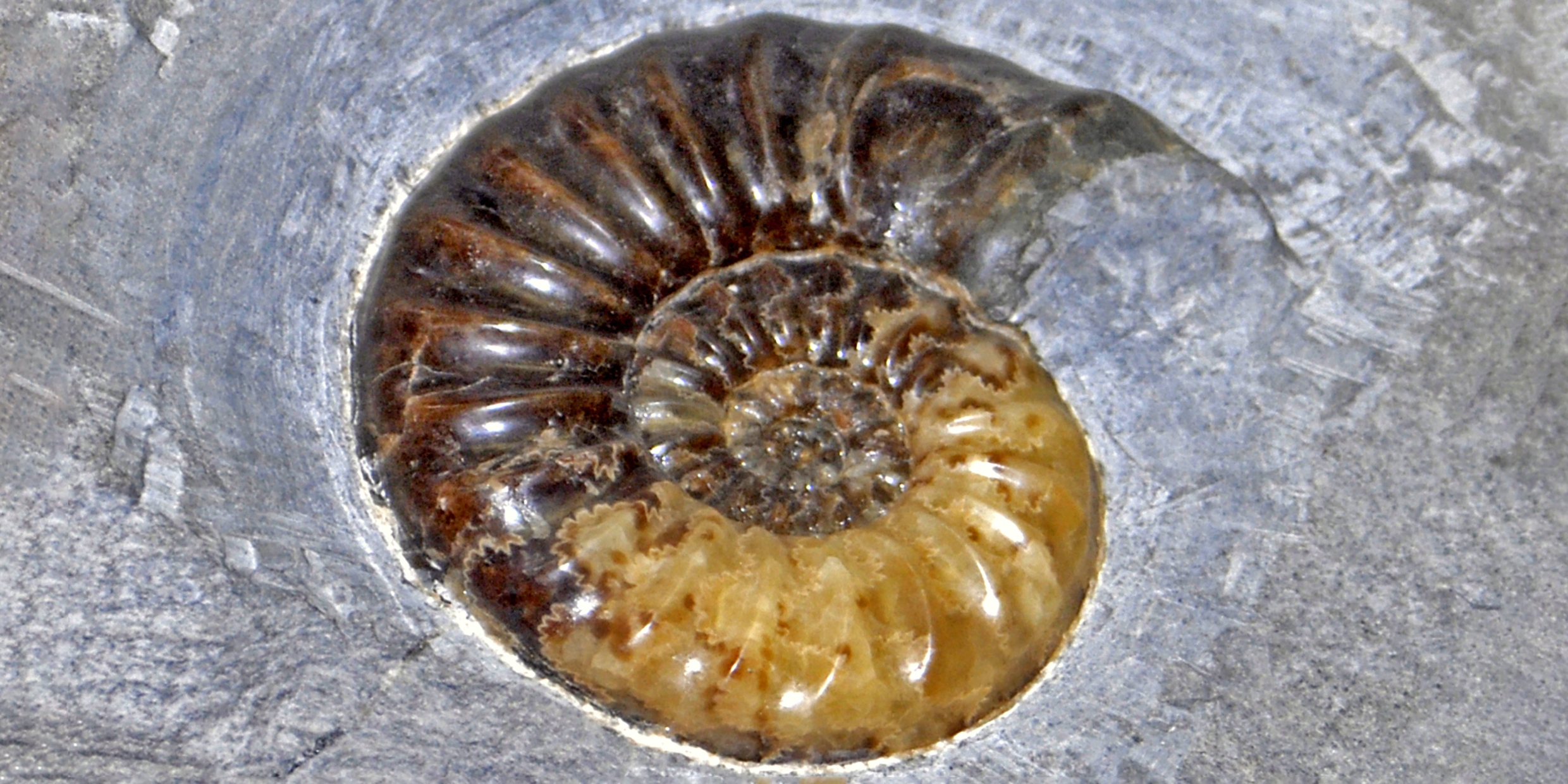Originally published 7 November 1994
My daughter, a geologist, recently returned from a visit to the high Himalayan plateau. She brought me a gift: a gray, naturally rounded stone, of a size that fills the hand with a satisfying heft.
It is a limestone cobble, polished in a mountain stream. A one-pound chunk of rock eroded from a towering peak — perhaps Everest, the highest place on Earth — transported by a glacier, tumbled by rushing water, finally tossed upon a bank of rounded stones at the side of a river in a remote valley.
The stone is cracked. Its top lifts away like the lid of a jewel box. And inside — a fossil ammonoid.
Ammonoids were sea creatures, now extinct, shelled relatives of squids and octopi, cousins of the chambered nautilus. The typical ammonoid shell is like a tightly spiraled ram’s horn, ribbed with wavy lines. From the Carboniferous to the Cretaceous eras of geological history — 350 to 65 million years ago — ammonoids were among the most abundant ocean animals, evolving thousands of species. Today, they dominate the fossil record of those far-off times.
The fossil inside my stone is about three inches in diameter. There are no signs of the animal’s soft tissues — the bulging eyes, the waving arms that searched for food. Only the shell has left its imprint in the rock. Still, the impression of a living thing is vivid. When I open the stone, it is as if I disturb the animal in its deep geological sleep.
I showed my fossil-bearing stone to a friend, and in return she shared with me a poem of Charles Simic, called Stone. The poet muses on what it is to be a stone, and — wonderfully — imagines the stone’s having an inside and an outside. The spirit of the stone resides in the cool dark interior, in hermit-like repose. If the stone is thrown into a river, writes Simic, it “sinks, slow, unperturbed/ To the river bottom/ Where the fishes come to knock on it/ And listen.”
He might have been thinking of my stone, with its hidden inner life.
One-hundred-million years ago, an ammonoid lived in a sea that then separated India from Asia. It died, and fell into limey sediments on the sea floor. These sediments grew deeper and hardened into rock. The shell calcified, became part of the stone, though maintaining every detail of its structure.
India was on the move, drifting on a slab of the Earth’s moving crust towards Asia. The floor of the intervening sea was forced under the Asian continent, back into the hot interior of the planet. As it descended, some of the limestone sediments were scraped off and piled against the overlying continent.
Meanwhile, about 65 million years ago, an asteroid smashed into the Earth, possibly near the tip of the present Yucatan Peninsula in Mexico. The place of impact was far from India and Asia, but the effects were global.
A vast quantity of dust was hurled into the atmosphere. Winds carried the dust worldwide, wrapping the planet in a dark shroud that sunlight could not penetrate. Temperatures fell. Photosynthesis ceased. Food chains collapsed.
The calamity caused the dinosaurs to become extinct.
But dinosaurs were not the only victims. Vast numbers of other plant and animal species perished, both on land and in the sea. Not least among them were the ammonoids. This wildly successful family of creatures disappeared from the Earth.
Only in the rocks did their images linger.
About 50 million years ago, the sea separating India and Asia was at last squeezed out of existence, and continents collided. A double-thickness continent was heaved into the air, creating the high Himalayan plateau. Among its crumpled rocks were the scraped-off sediments of the vanished seafloor. Some of these fossiliferous limestones were lifted to the peaks of the highest mountains, miles above the level of the sea.
Throughout all of this violence, my ammonoid slept, secure in its stony dreams.
Fish came to knock and listen. Water caressed it, whispering questions. The hand of crustal motion lifted the rock from out of its matrix, held it to its mountainous ear, shook and rattled.
The stone was silent, unperturbed.
In his poem, Simic wonders if the inside of a stone is dark. He has seen sparks fly out when two stones are struck together, he says, so perhaps there is a pale interior light, the light of a moon shining from behind a hill: “Just enough light to make out/ The strange writings, the star-charts/ On the inner walls.”
I open my stone, my daughter’s gift. Daylight floods the interior for the first time in 100 million years. Here on the inner walls, even as the poet guessed, are strange writings, telling of waters teaming with many-tentacled swimmers, of drifting continents, of asteroids, of limestone mountains lifted from the floor of a sea.
The sleep of eons disturbed, revealing the science of the past.



